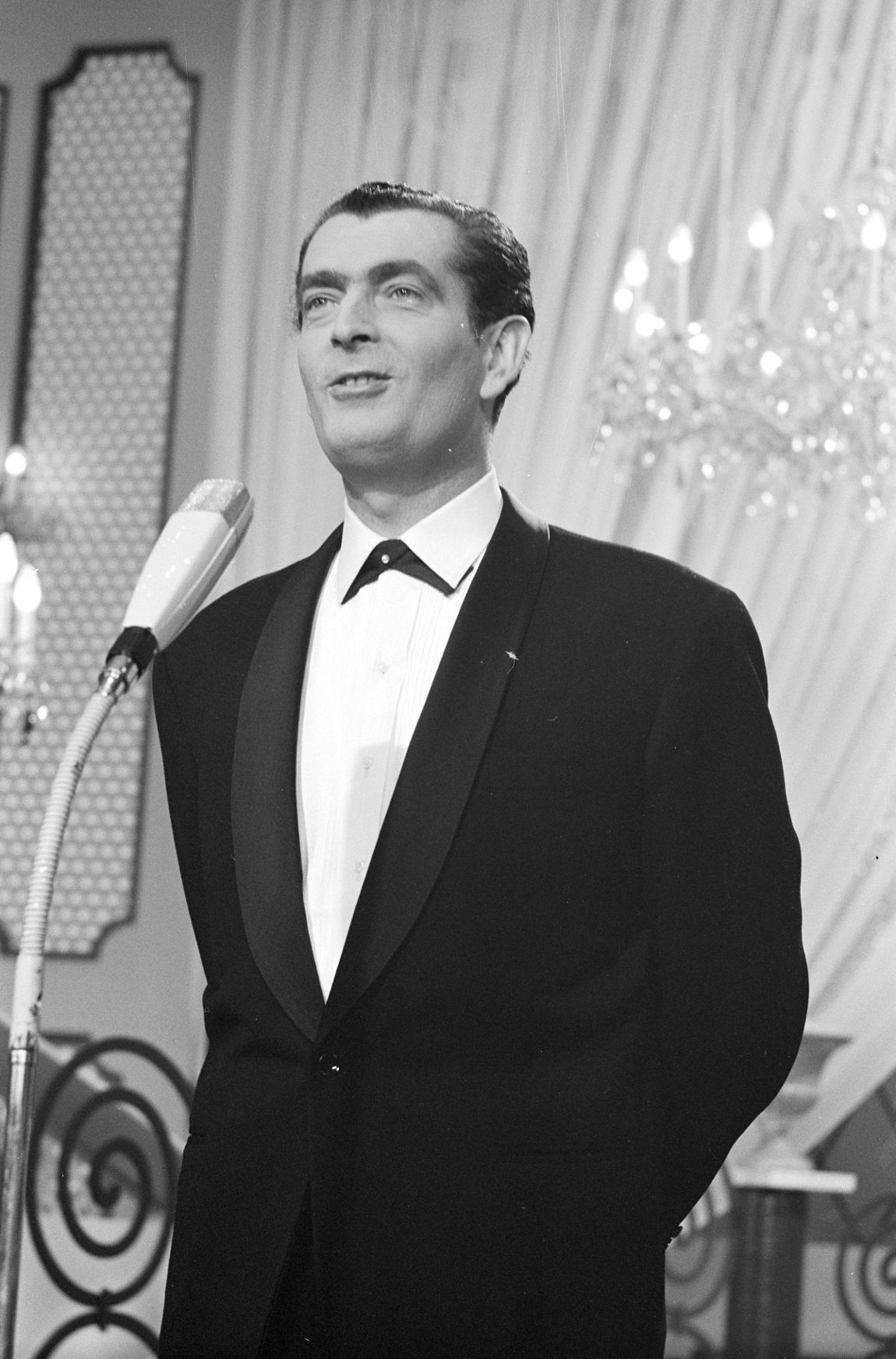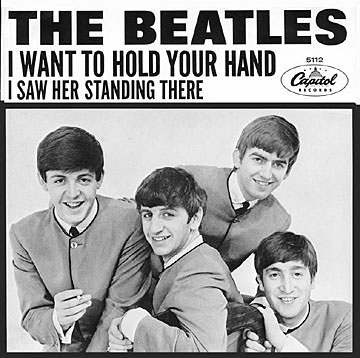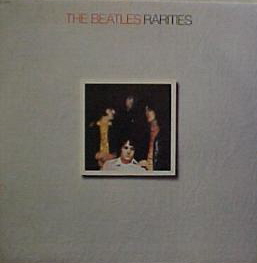 Search by Keyword
Sign Up Below for our MONTHLY BEATLES TRIVIA QUIZ!
|
"SIE LIEBT DICH"
(John Lennon - Paul McCartney - J. Nicolas - Montague)
 On March 12th, 1964, Beatles producer George Martin and engineer Norman Smith convened in the control room of EMI Studio Three in London to create stereo mixes of two songs that The Beatles reluctantly recorded on January 29th of that year in a recording studio in Paris. These two songs were German language versions of their two latest hit songs, "I Want To Hold Your Hand" and "She Loves You." The only reason they recorded these versions was because EMI's West German Branch, Electrola, was convinced that only German language music could make an impact in that country. On March 12th, 1964, Beatles producer George Martin and engineer Norman Smith convened in the control room of EMI Studio Three in London to create stereo mixes of two songs that The Beatles reluctantly recorded on January 29th of that year in a recording studio in Paris. These two songs were German language versions of their two latest hit songs, "I Want To Hold Your Hand" and "She Loves You." The only reason they recorded these versions was because EMI's West German Branch, Electrola, was convinced that only German language music could make an impact in that country.
 After these stereo mixes were made, copies of the tapes were sent to West Germany for release in that country. On a hunch, George Martin also sent copies of these tapes to Capitol Records in the US in case they might also be interested. They were. With "Beatlemania" in full swing, Capitol was interested in anything Beatles and, while looking for tracks to fill up another makeshift album called "Something New," they included the German version of "I Want To Hold Your Hand" which was entitled "Komm, Gib Mir Deine Hand." Wisely, they decided that two German songs on the same album was a little much, so for the time being, they passed on the German version of "She Loves You" which was entitled "Sie Liebt Dich." After these stereo mixes were made, copies of the tapes were sent to West Germany for release in that country. On a hunch, George Martin also sent copies of these tapes to Capitol Records in the US in case they might also be interested. They were. With "Beatlemania" in full swing, Capitol was interested in anything Beatles and, while looking for tracks to fill up another makeshift album called "Something New," they included the German version of "I Want To Hold Your Hand" which was entitled "Komm, Gib Mir Deine Hand." Wisely, they decided that two German songs on the same album was a little much, so for the time being, they passed on the German version of "She Loves You" which was entitled "Sie Liebt Dich."
 Surprisingly, this second German song did end up being released in the US in 1964, but not by Capitol Records. Swan Records out of Philadelphia, with dollar signs in their eyes, apparently acquired a copy of the German 45 and decided to push the envelope by releasing "Sie Liebt Dich" as a single in America. Therefore, while EMI declined to release either song in Britain at that time, American fans received both within months of them being recorded. Surprisingly, this second German song did end up being released in the US in 1964, but not by Capitol Records. Swan Records out of Philadelphia, with dollar signs in their eyes, apparently acquired a copy of the German 45 and decided to push the envelope by releasing "Sie Liebt Dich" as a single in America. Therefore, while EMI declined to release either song in Britain at that time, American fans received both within months of them being recorded.
Songwriting History
 On January 28th, 1964, popular German singer and lyricist Camillo Felgen, received a phone call requesting his assistance regarding two new songs being recorded by The Beatles. He was asked to translate "I Want To Hold Your Hand" and "She Loves You" into German and coach John, Paul and George in their pronunciation during a recording session to be held the next day. On January 28th, 1964, popular German singer and lyricist Camillo Felgen, received a phone call requesting his assistance regarding two new songs being recorded by The Beatles. He was asked to translate "I Want To Hold Your Hand" and "She Loves You" into German and coach John, Paul and George in their pronunciation during a recording session to be held the next day.
Camillo Felgen (who went by the pseudonym J. Nicolas on this occasion) was up for the task, even though he had a mere 24 hours to be in an EMI recording studio in Paris, the city where The Beatles happened to be performing at the time. Without much time to spare, he apparently enlisted help from someone with the last name (or pseudonym) Montague to adequately interpret the lyrics of "She Loves You" in German. In order to continue the hype surrounding the phrase "yeah, yeah, yeah," they were smart enough not to insist on translating it "ja, ja, ja."
 EMI Pathe Marconi Studios, Paris
|
Recording History
 With Camillo Felgen present, The Beatles were cajoled into EMI Pathe Marconi Studios in Paris on January 29th, 1964 to record "Sie Liebt Dich." First on the agenda, though, was recording the German vocals for "I Want To Hold Your Hand," which was done using the existing rhythm track brought over from Britain. With Camillo Felgen present, The Beatles were cajoled into EMI Pathe Marconi Studios in Paris on January 29th, 1964 to record "Sie Liebt Dich." First on the agenda, though, was recording the German vocals for "I Want To Hold Your Hand," which was done using the existing rhythm track brought over from Britain.
 However, much more work was needed to accomplish the second song of the day. The two-track tape that contained the original Beatles recording of "She Loves You" from July 1st, 1963 no longer existed. Therefore, The Beatles had to have their instruments brought into the studio to re-record the rhythm track before they could tackle the German vocals. However, much more work was needed to accomplish the second song of the day. The two-track tape that contained the original Beatles recording of "She Loves You" from July 1st, 1963 no longer existed. Therefore, The Beatles had to have their instruments brought into the studio to re-record the rhythm track before they could tackle the German vocals.
 With producer George Martin and engineers Norman Smith and Jacques Esmenjaud at the controls, The Beatles needed 14 takes to fully record the song. While Mark Lewisohn's informative book "The Beatles Recording Sessions" states that 13 takes were needed to record the rhythm track and only one was needed for the vocals, proof exists otherwise. There is a nine second excerpt from an aborted vocal take on this day heard on the Anthology film which ends in laughter from Paul and John. Obviously this wasn't the finished take so at least two attempts were made vocally to perfect the song. As it was, after "take 14," "they were extremely pleased to get it over with," as Norman Smith recalls. With producer George Martin and engineers Norman Smith and Jacques Esmenjaud at the controls, The Beatles needed 14 takes to fully record the song. While Mark Lewisohn's informative book "The Beatles Recording Sessions" states that 13 takes were needed to record the rhythm track and only one was needed for the vocals, proof exists otherwise. There is a nine second excerpt from an aborted vocal take on this day heard on the Anthology film which ends in laughter from Paul and John. Obviously this wasn't the finished take so at least two attempts were made vocally to perfect the song. As it was, after "take 14," "they were extremely pleased to get it over with," as Norman Smith recalls.
 The new performance of the song recorded on this day is so similar to the original version that much speculation exists as to whether it was a new recording at all. Even though there are differences in the instrumental parts (especially George Harrison's lead guitar lines) some say that the original session tape (or a copy thereof) from June 1st, 1963 did still exist at this time and was brought to Paris as was "I Want To Hold Your Hand." These theorists explain away the instrumental differences as being due to the extensive editing that was done on the finished master of "She Loves You." The new performance of the song recorded on this day is so similar to the original version that much speculation exists as to whether it was a new recording at all. Even though there are differences in the instrumental parts (especially George Harrison's lead guitar lines) some say that the original session tape (or a copy thereof) from June 1st, 1963 did still exist at this time and was brought to Paris as was "I Want To Hold Your Hand." These theorists explain away the instrumental differences as being due to the extensive editing that was done on the finished master of "She Loves You."
 Upon listening with a critical ear, the differences are a little too plentiful for this conclusion. First of all, the tempo is slightly faster but the key is virtually the same, which excludes the idea of the tape running a little faster. Also, if you listen to the guitar flourishes at the conclusion of the song, it's obvious that these were recorded fresh on January 29th, 1964. It has been proposed that they were listening to the original song while recording the rhythm track on this day, which seems a little more feasible. At any rate, it can easily be established that this was indeed a new recording. Upon listening with a critical ear, the differences are a little too plentiful for this conclusion. First of all, the tempo is slightly faster but the key is virtually the same, which excludes the idea of the tape running a little faster. Also, if you listen to the guitar flourishes at the conclusion of the song, it's obvious that these were recorded fresh on January 29th, 1964. It has been proposed that they were listening to the original song while recording the rhythm track on this day, which seems a little more feasible. At any rate, it can easily be established that this was indeed a new recording.
 Since they had their instruments there, and with time left in the recording session, The Beatles took advantage of the occasion and recorded the bulk of a new McCartney number "Can't Buy Me Love." With both German songs completed, they could go ahead and cancel the recording session they had booked for January 31st, 1964, which meant that Camillo Felgen was now free to fly back home. Since they had their instruments there, and with time left in the recording session, The Beatles took advantage of the occasion and recorded the bulk of a new McCartney number "Can't Buy Me Love." With both German songs completed, they could go ahead and cancel the recording session they had booked for January 31st, 1964, which meant that Camillo Felgen was now free to fly back home.
.jpg) A quick mono mix of the song was made sometime before the session was over, this immediately being shipped to Odeon Records in West Germany for their February 4th, 1964 single release. The official mono mix of the song was made back in EMI in the control room of Studio Two in London on March 10th, 1964 by George Martin and Norman Smith. The stereo mix, with instruments entirely on one channel and vocals entirely on the other, was made on March 12th, 1964 in the control room of EMI Studio Three, also by George Martin and Norman Smith. Copies of these mixes were then sent to America in case they might be interested. A quick mono mix of the song was made sometime before the session was over, this immediately being shipped to Odeon Records in West Germany for their February 4th, 1964 single release. The official mono mix of the song was made back in EMI in the control room of Studio Two in London on March 10th, 1964 by George Martin and Norman Smith. The stereo mix, with instruments entirely on one channel and vocals entirely on the other, was made on March 12th, 1964 in the control room of EMI Studio Three, also by George Martin and Norman Smith. Copies of these mixes were then sent to America in case they might be interested.
Song Structure and Style
 Because of their strong familiarity from performing it extensively in their stage act, and possibly assisted by listening to the record in the studio, they nailed an excellent musical performance of the song in EMI's Paris studio on this day. And after much encouragement and reprimanding to get them into the studio at all (see "Recording History" under "Komm, Gib Mir Diene Hand"), they ended up delivering a spirited vocal performance with excellent pronunciation. The trademark Glenn Miller-like ending harmonies were also excellently done. Because of their strong familiarity from performing it extensively in their stage act, and possibly assisted by listening to the record in the studio, they nailed an excellent musical performance of the song in EMI's Paris studio on this day. And after much encouragement and reprimanding to get them into the studio at all (see "Recording History" under "Komm, Gib Mir Diene Hand"), they ended up delivering a spirited vocal performance with excellent pronunciation. The trademark Glenn Miller-like ending harmonies were also excellently done.
(As for the complete "Song Structure and Style" of this track, please see "She Loves You.")
American Releases
 Philadelphia based Swan Records was staying afloat primarily due to them landing the rights to release "She Loves You" in America after Capitol had passed on the opportunity. While the single flopped when first released, it amassed great radio airplay and sales when 1964 Beatlemania swept the country early in the year. It became The Beatles second #1 hit in the US, with Swan Records happy to have taken a chance on this unknown British group. Philadelphia based Swan Records was staying afloat primarily due to them landing the rights to release "She Loves You" in America after Capitol had passed on the opportunity. While the single flopped when first released, it amassed great radio airplay and sales when 1964 Beatlemania swept the country early in the year. It became The Beatles second #1 hit in the US, with Swan Records happy to have taken a chance on this unknown British group.
 Unfortunately for them, Capitol exercised their "right of first refusal" and finally welcomed The Beatles to their label starting with their very next release, "I Want To Hold Your Hand." This meant that Swan Records only had the rights to release two Beatles songs, these being "She Loves You" and it's b-side "I'll Get You," and only as a single. Capitol took advantage of this limitation by including both of these songs on "The Beatles' Second Album," released on April 10th, 1964. Unfortunately for them, Capitol exercised their "right of first refusal" and finally welcomed The Beatles to their label starting with their very next release, "I Want To Hold Your Hand." This meant that Swan Records only had the rights to release two Beatles songs, these being "She Loves You" and it's b-side "I'll Get You," and only as a single. Capitol took advantage of this limitation by including both of these songs on "The Beatles' Second Album," released on April 10th, 1964.
 Wanting to milk The Beatles name for whatever they could, Swan took some liberties by releasing an ill fated second single. They apparently acquired a copy of the German single "Sie Liebt Dich" and, assuming that since this was a German version of a song they already had under contract to release as a single, decided to market it as a new Beatles single in America on May 21st, 1964. The only other song they had rights to was "I'll Get You," so obviously that was the b-side of this single as well. Swan hoped that the novelty of hearing The Beatles sing in German would be enough to obtain radio air play and sales. Wanting to milk The Beatles name for whatever they could, Swan took some liberties by releasing an ill fated second single. They apparently acquired a copy of the German single "Sie Liebt Dich" and, assuming that since this was a German version of a song they already had under contract to release as a single, decided to market it as a new Beatles single in America on May 21st, 1964. The only other song they had rights to was "I'll Get You," so obviously that was the b-side of this single as well. Swan hoped that the novelty of hearing The Beatles sing in German would be enough to obtain radio air play and sales.
 To extend the novelty even furter, Swan Records copied the German single's artist listing as "Die Beatles" to attract some attention. Unfortunately, "die" was an appropriate term for this single because it failed to attract much attention at all. It only charted briefly, peaking at #97 on the Billboard Hot 100. They also failed to list the German translators as songwriters, attributing the song only to "Lennon / McCartney." To extend the novelty even furter, Swan Records copied the German single's artist listing as "Die Beatles" to attract some attention. Unfortunately, "die" was an appropriate term for this single because it failed to attract much attention at all. It only charted briefly, peaking at #97 on the Billboard Hot 100. They also failed to list the German translators as songwriters, attributing the song only to "Lennon / McCartney."
 One probable reason why the single failed so miserably was that Capitol Records filed a lawsuit against Swan for releasing the record. Steven Binnick, son of Swan Records co-owner Bernie Binnick, recalled the lawsuit, although Philadelphia court records had since been purged leaving the details of the lawsuit a mystery. Steven Binnick does remember, however, that the lawsuit was settled quickly, Capitol stating that they wouldn't seek damages as long as they immediately discontinued distribution of the "Sie Liebt Dich" single. As was pointed out to them, their original contract stated that they had the rights to the specific master recordings they received from EMI in Britain, not the songs themselves. Their assumption about the legality of releasing the German single turned out to be incorrect. While the "Sie Liebt Dich" single got off to a slow start, their agreement to cease manufacturing it put any chance of it becoming a hit to a sudden halt. Therefore, this resulted in the scarcity of legitimate copies of the single available today. Swan Records did eventually close their doors three years later, which allowed Capitol to release the song as they saw fit. One probable reason why the single failed so miserably was that Capitol Records filed a lawsuit against Swan for releasing the record. Steven Binnick, son of Swan Records co-owner Bernie Binnick, recalled the lawsuit, although Philadelphia court records had since been purged leaving the details of the lawsuit a mystery. Steven Binnick does remember, however, that the lawsuit was settled quickly, Capitol stating that they wouldn't seek damages as long as they immediately discontinued distribution of the "Sie Liebt Dich" single. As was pointed out to them, their original contract stated that they had the rights to the specific master recordings they received from EMI in Britain, not the songs themselves. Their assumption about the legality of releasing the German single turned out to be incorrect. While the "Sie Liebt Dich" single got off to a slow start, their agreement to cease manufacturing it put any chance of it becoming a hit to a sudden halt. Therefore, this resulted in the scarcity of legitimate copies of the single available today. Swan Records did eventually close their doors three years later, which allowed Capitol to release the song as they saw fit.
 They didn't see fit until 1978 when they released it as a single with "Komm, Gib Mir Deine Hand" as the a-side, but this was only as "Demonstration - Not For Sale" 12" promotional single on colored vinyl, one pressing in clear red and another in pink. While there was a resurgence in The Beatles popularity at the time, Capitol chose not to release the single commercially, making this promo disc quite valuable today. They didn't see fit until 1978 when they released it as a single with "Komm, Gib Mir Deine Hand" as the a-side, but this was only as "Demonstration - Not For Sale" 12" promotional single on colored vinyl, one pressing in clear red and another in pink. While there was a resurgence in The Beatles popularity at the time, Capitol chose not to release the single commercially, making this promo disc quite valuable today.
 The next release of the song didn't come until March 24th, 1980, on the Capitol album "Rarities," which was issued in answer to the popular British album of the same name released in December of 1978. This was the first time it was ever released on an album in the US. Acknowledging the existence of the Swan single, their liner notes cuttingly proclaimed that the song was "once released here as a low-quality single on a small label." Once again, the songwriter credits fail to mention the translators Nicolas and Montague. The next release of the song didn't come until March 24th, 1980, on the Capitol album "Rarities," which was issued in answer to the popular British album of the same name released in December of 1978. This was the first time it was ever released on an album in the US. Acknowledging the existence of the Swan single, their liner notes cuttingly proclaimed that the song was "once released here as a low-quality single on a small label." Once again, the songwriter credits fail to mention the translators Nicolas and Montague.
 On March 7th, 1988, "Past Masters, Volume One" was released on compact disc as a companion to all the recently released British albums on CD. The purpose of the disc was to complete the entire Beatles cannon as available on CD at that time. "Sie Liebt Dich" made this volume, which appeared as a "narrow" mix that mostly centers the left and right channels of stereo to eliminate the distinct separation of the original stereo mix. On October 24th, 1988, this album was combined with its companion album "Past Masters, Volume Two" and released as a vinyl double-album. On March 7th, 1988, "Past Masters, Volume One" was released on compact disc as a companion to all the recently released British albums on CD. The purpose of the disc was to complete the entire Beatles cannon as available on CD at that time. "Sie Liebt Dich" made this volume, which appeared as a "narrow" mix that mostly centers the left and right channels of stereo to eliminate the distinct separation of the original stereo mix. On October 24th, 1988, this album was combined with its companion album "Past Masters, Volume Two" and released as a vinyl double-album.
 When the entire Beatles catalog was remastered and released on September 9th, 2009, the "Past Masters" set was released as a 2-CD set, a remastered vinyl double-album coming out on November 12th, 2012. On both of these remastered releases, the original stereo mix, with its distinctive separation, was restored as George Martin intended. When the entire Beatles catalog was remastered and released on September 9th, 2009, the "Past Masters" set was released as a 2-CD set, a remastered vinyl double-album coming out on November 12th, 2012. On both of these remastered releases, the original stereo mix, with its distinctive separation, was restored as George Martin intended.
 On September 9th, 2009, the CD box set "The Beatles In Mono" was released. A disc contained in this set entitled "Mono Masters" features a remastered mono mix of "Sie Liebt Dich," the vinyl edition of this box set coming out on September 9th, 2014. On September 9th, 2009, the CD box set "The Beatles In Mono" was released. A disc contained in this set entitled "Mono Masters" features a remastered mono mix of "Sie Liebt Dich," the vinyl edition of this box set coming out on September 9th, 2014.
Conclusion
 The Beatles have broken many records at the time when it comes to the Billboard Hot 100 in the US, such as "Most Consecutive Number One Singles" (3), "Greatest Monopoly Of The Top Five" (all five positions) and "Greatest Monopoly Of The Hot 100" (14 positions in the chart on the same week). With "Sie Liebt Dich" also making the Billboard Hot 100 at #97, a further record was broken, that of The Beatles being the only artist in American history to hit the chart with the same song in two different languages! I suppose one could say they've truly "made it" if they can manage to accomplish that. The Beatles have broken many records at the time when it comes to the Billboard Hot 100 in the US, such as "Most Consecutive Number One Singles" (3), "Greatest Monopoly Of The Top Five" (all five positions) and "Greatest Monopoly Of The Hot 100" (14 positions in the chart on the same week). With "Sie Liebt Dich" also making the Billboard Hot 100 at #97, a further record was broken, that of The Beatles being the only artist in American history to hit the chart with the same song in two different languages! I suppose one could say they've truly "made it" if they can manage to accomplish that.
Song Summary
"Sie Liebt Dich"
Written by: John Lennon / Paul McCartney / J. Nicolas / Montague
Instrumentation (most likely):
- John Lennon - Lead Vocals, Rhythm Guitar (1964 Rickenbacker 325)
- Paul McCartney - Lead and Harmony Vocals, Bass Guitar (1963 Hofner 500/1)
- George Harrison - Lead Guitar (1963 Gretsch 6122 Country Gentleman), Harmony Vocals
- Ringo Starr - Drums (1963 Ludwig Downbeat Black Oyster Pearl)
Written and compiled by Dave Rybaczewski
|
IF YOU WOULD LIKE TO MAKE A DONATION TO KEEP THIS WEBSITE UP AND RUNNING, PLEASE CLICK BELOW!
|